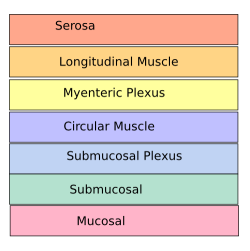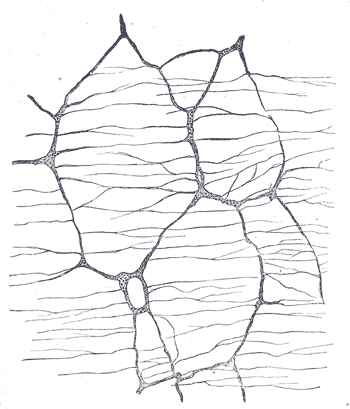Enteric nervous system
 From Wikidoc - Reading time: 4 min
From Wikidoc - Reading time: 4 min

Overview[edit | edit source]
The enteric nervous system (ENS) is a subdivision of the Peripheral Nervous System, that directly controls the gastrointestinal system. It is capable of autonomous functions such as the coordination of reflexes, although it receives considerable innervation from the autonomic nervous system and thus is often considered a part of it. Its study is the focus of neurogastroenterology. It has as many as one billion neurons, one hundredth of the number of neurons in the brain, and considerably more than the number of neurons in the spinal cord. It has become a colloquialism among university students to refer to this subdivision as the "Poo-Poo Brain".
Layers[edit | edit source]
The neurons of the ENS are collected into two types of ganglia: myenteric (Auerbach's) and submucosal (Meissner's) plexuses. Myenteric plexuses are located between the inner and outer layers of the muscularis externa, while submucosal plexuses are located in the submucosa.
Complexity[edit | edit source]
There are several reasons why the enteric nervous system may be regarded as a second brain. The enteric nervous system can operate autonomously. It normally communicates with the CNS through the parasympathetic (eg, via the vagus nerve) and sympathetic (eg, via the prevertebral ganglia) nervous systems. However, vertebrate studies show that when the vagus nerve is severed, the enteric nervous system continues to function.
The complexity of the enteric nervous system is another reason for its status as a second brain. In vertebrates the enteric nervous system includes efferent neurons, afferent neurons, and interneurons, all of which make the enteric nervous system capable of carrying reflexes in the absence of CNS input. The sensory neurons report on mechanical and chemical conditions. Through intestinal muscles, the motor neurons control peristalsis and churning of intestinal contents. Other neurons control the secretion of enzymes. The enteric nervous system also makes use of the same neurotransmitters as the CNS, such as acetylcholine, dopamine, and serotonin. The enteric nervous system has the capacity to alter its response depending on such factors as bulk and nutrient composition.
References[edit | edit source]
- The book The Second Brain by Dr. Michael D. Gershon
- "The Enteric nervous system (ENS)" at anaesthetist.com
- Saffrey M (2004). "Ageing of the enteric nervous system". Mech Ageing Dev. 125 (12): 899–906. PMID 15563936. Link
- Grundy D, Schemann M (2006). "Enteric nervous system". Curr Opin Gastroenterol. 22 (2): 102–10. PMID 16462164. Link
- Furness JB (2006) The Enteric Nervous System. Blackwell, Oxford, pp 274
External links[edit | edit source]
- Essentials of Human Physiology by Thomas M. Nosek. Section 6/6ch2/s6ch2_29.
Additional images[edit | edit source]
-
The myenteric plexus from the rabbit. X 50.
-
The plexus of the submucosa from the rabbit. X 50.
de:Enterisches Nervensystem dv:އެންޓީރިކް ނާރވަސް ސިސްޓަމް Template:WH Template:WikiDoc Sources
 KSF
KSF
